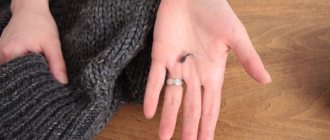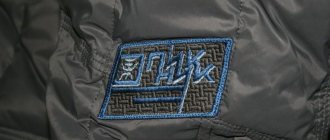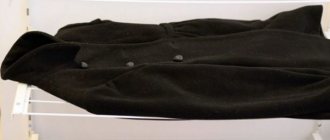To properly dry a down item, it must be washed properly. Therefore, this process is carried out using delicate detergents and special programs in washing machines.
It must be remembered that the jacket cannot be soaked or washed in water above 30 degrees. Otherwise, you won’t be able to dry your clothes properly.
Let's look at how to dry a down jacket after washing at home.
Basic Rules
To preserve things made from feather fillings, they need high-quality, proper drying, which is only possible if the following rules are observed:
- choosing the right location is half the battle. Features of the drying room should include constant air circulation and an acceptable temperature (not higher than 28 degrees). Various types of heating devices and heaters should not directly affect the down jacket;
- drying the down jacket should take place in a horizontal position, this will prevent the formation of lumps of wet down at the bottom of the jacket, after which it will be almost impossible to return to its original appearance;
- when the item dries, you need to systematically beat it and fluff up the filler, this will allow it to evenly fill the jacket and detect lumps in time;
- The product must be dried until it is completely dry, no matter how long it dries, otherwise there is a risk of mold formation. You can check the degree of dryness by squeezing the bottom of the down jacket into a fist; if you feel moisture, you need to continue drying.
How to dry a fur edge?
If the jacket required a complete wash, then the fur trim was also treated.
It is better to wash the fur by hand and dry it in the open air . After complete drying, it is combed against the growth of the coat, and then in the direction of growth.
Only completely dry fur can be fastened to the jacket and sent for storage.
How to properly dry a down jacket after hand washing
After hand washing, many times more water may remain inside the down jacket than after washing in a machine.
In order for most of the water to drain out, the jacket can be spread over the bathtub, on a special rack or dryer.
If possible, you can wring out the item in a machine at minimum speed using special balls. Or squeeze it with your hands using light squeezing movements, without resorting to twisting the product.
After most of the water has drained away, further drying should take place in a horizontal position on a clean surface, having first straightened out all the irregularities and creases.
The ideal option to dry a down jacket after washing is to lay it out so that there is air access from all sides.
This can be achieved using a floor dryer by stretching several ropes between two vertical planes and placing the jacket on them.
At all stages of drying, the item must be kneaded and checked for the presence of compacted formations, which will allow it to dry well and the filler not to suffocate.
“Massage” should be carried out both from the inside and from the outside, paying special attention to the areas of seams, collar, hem and sleeves.
The down jacket should be shaken several times a day to ensure even distribution of the filler.
Not drying completely can lead to mold formation. On average, a down jacket takes a couple of days to dry.
Features of drying down jackets of different models
The variety of winter outerwear today is very large. The choice depends on taste, budget, lifestyle. To extend the life of any wardrobe item, it needs to be cleaned or washed. Dry cleaning allows you to pick up a product that is ready for storage, while self-washing leaves behind the question of how to quickly dry the jacket so that it can be packed away during the summer heat.
Quilted
Different models require some subtleties of care. Quilted down jackets with stitched inner tubes are best dried vertically. The seams securely fix the filler inside each compartment and prevent the fluff from bunching up into one big lump. To prevent the jacket from drying for too long, place it on a hanger in a well-ventilated, warm room.
Unquilted
A down jacket without quilting is distinguished by the fact that the filling inside it is not fixed in any way. This is why such a product needs to be dried in a horizontal position: wet down will not fall down the jacket.
Periodically, the coat should be fluffed with your hands to better distribute the dried insulation, and after the clothes are completely dry, fluff them up like a pillow.
How to dry a down jacket after washing in a machine
Drying a down jacket washed automatically should begin with a spin at low speeds using balls.
After this procedure, the item will not be wet, but damp, which will make drying easier.
If the product is quilted, you can hang it to dry by its hangers, remembering to feel and shake it.
If the item is not completely quilted or not quilted at all, it should only be dried on a horizontal plane.
In this case, it is also necessary to periodically shake and break the filler.
How to avoid lumps
To prevent the jacket stuffing from deforming into clumps, light plastic tennis balls are placed inside the drum. You can purchase tourmaline, magnetic or plastic balls at a household chemical store or using online resources. They will ensure uniform distribution of down or artificial filler throughout the inner cavity of the down jacket; they will fluff them up during the entire washing process, making drying more pleasant.
If the rules were violated and lumps still formed, lay the item on a horizontal surface and periodically knead the fluff manually or using a rolling pin or cracker to knock dust out of carpets.
https://www.youtube.com/watch?v=CRy_IYfiPWk
How to dry a down jacket in a dryer and washing machine
Drying down items can be done in either a washing machine or a dryer. Modern washing machines are designed to dry delicate items.
Before this procedure, you need to study the information on the item’s label, which will tell you whether this method can be used. If there are no contraindications, then this will happen as follows:
- the down jacket is fastened with all the locks and zippers, turned inside out and placed in the machine;
- 4-5 special balls or tennis balls are placed there, along with the jacket (they must be checked for color fastness);
- The machine starts in the “delicate drying” mode at no more than 500 rpm.
Drying a product in a dryer is practically the same as in a washing machine.
Before you start drying your jacket, after washing it directly, you should inspect it to see if any feathers or fluff are coming out. Otherwise, when the centrifuge is running, there is a possibility that it will come out even more.
How to fix mistakes
If, after drying at home, it was not possible to avoid matted fluff or stains, you can try to fix everything:
- Disassemble the lump manually - take it with your hands from both sides of the product and carefully stretch it in different directions. Afterwards, you need to leave the jacket for a while for additional drying, because the fluff inside may be damp.
- Stains can be washed away with a sponge. If this method turns out to be ineffective, it is better to wash the product or rinse it additionally in the washing machine and dry it according to all the rules.
How to dry a down jacket with padding polyester filling
As in the case of down and feathers, it is better to choose natural drying for synthetic padding filler.
Artificial heat sources that emit high temperatures can have a detrimental effect on the item, namely, deform both the filler and the lining fabric.
Unlike down products, a synthetic down jacket can be immediately hung on a hanger in the fresh air. In a sunny place, the jacket will dry in a couple of hours.
If there is a need for express drying, you can use a household fan at maximum speed.
If lumps form in the padding polyester filler, you can get rid of them using a carpet beater.
How to dry something as quickly as possible?
If you need to dry a washed item as quickly as possible without damaging the filling, you will have to waste time. For these purposes , you can use household appliances such as a hair dryer or vacuum cleaner .
The jacket is hung on hangers and treated with warm (not hot) air. Its flow is directed onto the surface of the jacket from a distance of at least 15-20 cm. The treatment is carried out slowly, element by element.
Periodically, the item must be shaken well so that the fluff does not cake and dries evenly. If it gets into clumps, they are carefully sorted out with your hands through the fabric.
Often, uneven distribution of down filling after washing can be found in the pocket area and along the seams.
To speed up the drying process, the jacket must be treated with warm air from both the inside and the outside .
What not to do when drying
When planning to dry your down item, there are a few things you should know that can harm your jacket and which you should avoid.
Heating devices
At the household level, you can often find the use of heating devices, such as radiators, various heaters and batteries, to dry down jackets as quickly as possible.
Their use can cause irreparable harm and spoil the appearance of the jacket. Only indirect influence of heat sources on the product located at a distance is permissible.
Quick blow dry
Using a hair dryer as a method of express drying is acceptable, but not on a regular basis. Positioning it no closer than 30 cm, turn on the minimum setting and dry, running over the entire surface from the wrong side.
Gas stove
Under no circumstances should you dry a down item over an open fire. Near the gas stove. This is not only the possibility of the external material melting, but also a serious danger of the item catching fire, which in turn can cause a fire!
Iron
Using an iron for this procedure is a risky step. The possibility of its use and temperature conditions can be seen on the product label.
If it is permissible to use an iron, the item must be covered with a non-fading fabric, such as cotton. After ironing, shake and hang, briefly in a draft.
Drying safety precautions
A down jacket is a very delicate wardrobe item. It requires careful handling, especially during washing and drying.
- You cannot dry a down jacket on a radiator - this is extremely detrimental to the product. White streaks may appear on the front side, and the fluff may become hopelessly crumpled.
- Do not dry it near an open fire - the fabric may melt. It is not recommended to use heaters (fans are the only exception).
- Avoid drying in a damp room. At high humidity, the fluff will not dry out, become dense, and the process of molding will begin. It will be impossible to wear it due to the disgusting musty smell.
Worth knowing! When drying a down jacket, you should pay attention to the seams - this is where the most moisture accumulates, and they take longer to dry.
Correcting errors
The most common drying problem is the formation of compactions in the down filling, in other words the formation of clumps. This flaw is corrected by manually straightening and kneading the fluff.
We also recommend reading our article “Proven ways to fluff up down in a down jacket after washing”
Another “popular” drawback is the appearance of stains on the fabric of the product, which can be easily removed with a sponge and detergent. The disadvantage of this method is the possible re-washing of the down jacket.
The resulting stains can be of two types:
- white are stains from detergents that were not rinsed out;
- yellow-red spots - the nature of their occurrence may be due to mistakes made during drying, or it may be fatty secretions from feathers.
Both of these types can be eliminated by proper washing with liquid detergents and thorough rinsing.
How to fluff up the down and feathers of a winter jacket
To prevent fluff and feathers from becoming tangled, tennis balls are placed in the machine drum during washing. They beat the filler, distributing it evenly across sectors of clothing. Two or three balls will be enough to cope with this task. You should not use high spin speeds: at high spin speeds, the filler gets tightly packed into piles, which will be extremely difficult to straighten. After the jacket has dried a little, you need to constantly shake the product, carefully straighten the clumps with your hands, and separate them into fibers. This should be done until there are no hard clumps of fluff left. When the filler dries sufficiently, it will distribute itself among the cells. This whole process takes a considerable amount of time and effort, but as a result, the down jacket dries faster, and the filler does not lose its properties.
Reference. Up to 30% feather is added to down jackets to reduce production costs and create a weightless frame that holds its shape and prevents clumps.
Important tips for caring for clothes
There are several rules, compliance with which will ensure the durability of the item. These tips apply to outerwear with any filling. Before washing, be sure to read the care label. You can find the following information there:
- washing temperature;
- type of washing - machine or hand;
- Possibility of dry cleaning and ironing;
- spin level;
- drying method.
Following the rules on the labels will help maintain the original appearance of the jacket. You should not wash and dry a down jacket in an automatic machine if this is prohibited by the instructions. It is better to resort to hand washing, use a brush or take the product to dry cleaning. In most cases, down jackets indicate the best way to dry them.
After rinsing, you should be patient and let the down jacket dry thoroughly. This will take from one to three days. During this period, you need to ensure good air ventilation in the room or on the balcony. If the jacket is stitched correctly, the down and feathers will be distributed evenly without additional manipulation. Most winter coats cannot be ironed; a garment steamer may be used. If the fluff and feathers have bunched up into dense clumps, you can put the product in the freezer for several hours, then carefully separate the filling with your fingers. Before hanging your clothes in the closet, you should make sure they are completely dry. To do this, you need to squeeze the lining with your hands in several places - there should be no wet spots on the surface. A poorly dried item can become moldy and acquire an unpleasant odor, which will be difficult to get rid of in the future.
Tips and tricks
If the fluff still gets lost, do not rush to get upset. With a little effort you can solve the problem in two ways:
- Place the still damp down jacket back into the washing machine. Throw 3-4 tennis balls into the drum and turn on the “Spin” mode again. The balls will help break up the fluff.
- Remove the attachment from the vacuum cleaner and gently vacuum the down jacket on low power. The air flow will help the filler to distribute evenly.
It is advisable to tidy up your outerwear after the season. If it is stored for a long time with contaminants, it will be much more difficult to remove them.
Note! It is not recommended to wash a down jacket more than twice a year.
When washing a down jacket in the washing machine, follow simple recommendations and be sure to read the label. This will help preserve your outerwear, which will keep you warm for a long time.
When you shouldn't wash a down jacket
If the degree of contamination of the down jacket is not too great, you should refuse to wash it. As a rule, only the outer material on the sleeves, collar, and near the pockets becomes dirty. First, you should clean them separately, without washing.
- Before washing, you should consider the product label, on which the manufacturer provides basic information about the materials, filler, and cleaning methods. From the label you can find out whether the product should be washed or whether it can be dry cleaned.
- To clean, you need to take a sponge, slightly moisten it and add gel, liquid soap (sometimes shampoo is used). After the contaminated area is cleaned, the sponge should be rinsed and the problem area treated again. This must be done several times until the foam or white streaks completely disappear.
- If you are not confident in the quality of your down jacket, it is best to take it to a dry cleaning station, where it will be cleaned using gentle and highly effective methods.
Washing and drying a down jacket is a labor-intensive task. It is important to comply with all conditions and remember the warnings. Otherwise, you can not only ruin its appearance, but also completely render it unusable.
Wash
The process of washing a down jacket will take a lot of time. But there is no need to try to save money and turn on the normal mode or put other things in the machine. Keeping your outerwear looking perfect takes effort.
This video clearly shows how you can wash a down jacket that has stains of unknown origin. At the beginning, a label is shown on which the icons prohibiting hand washing and a circle with the letter “F” are visible, which means the use of professional washing with certain preparations is possible.











